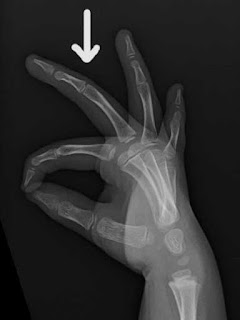Symphalangism is one type of finger stiffness; I previously written about it here. I wanted to share a few more thoughts. In addition to the classification noted in my other post, I often think of symphalangism in terms of whether or not the fingers are short. Whether the fingers are short or not, symphalangism is quite rare.
Flatt and Wood reported on symphalangism and divided it into 3 types (a long time ago- 1975, in the journal Hand)
– Symphalangism with normal length fingers (i.e. True Symphalangism)
– Symphalangism with short fingers (symbrachydactyly)
– Symphalangism with another syndrome like Aperts
The clinical examination is notable for the lack of motion of one or more of the interphalangeal joints- typically the proximal interphalangeal joint. It can be one finger or it can be many fingers. Importantly, the normal creases of the fingers are not there in symphalangism.
 |
| The arrow is pointing to the top of the PIP joint of the pointer (index) finger. Note the normal creases which demonstrate that the finger has been moving. |
Kids with symphalagism lack the normal joint development and therefore lack motion and therefore lack the creases. Here is one child with symphalangism affecting both hands.
 |
| Symphalangism. This is the child attempting to make a full fist. The PIP joints do not flex (bend) much. |
 |
The other hand in Symphalangism. This is the child attempting to make a full fist. The PIP joints do not flex (bend) much.
Also note the lack of creases on the tops of the fingers. |
 |
| Careful review of the x- rays show that the PIP joints have not developed in symphalangism. |
 |
Lateral view (side view) of the hand and fingers. The PIP joints have not developed in symphalangism. The arrow marks the PIP joint of the long finger (middle finger).
|





Hi can symphalangism also effect the distal and middle phalange? In my family only 4 out of about 40 of us have our distal and middle phalange fused together. My grandmother, my oldest ain't, me, and a cousin 3 years younger than me are affected. For me, 4 of my toes and fingers are fused in this way. All 8 of my younger cousins fingers are affected. Not surround my previous comments got sent through so I'm posting one more time just in case.
I am sorry your other comments didn't get through- not sure what happened.
Symphalangism can and does affect the middle phalanx (classic). You may have one of the types of brachydactyly (with hand and foot involvement). This post http://congenitalhand.wustl.edu/search?q=brachydactyly may help.
Good luck.
We have discovered what appears to be symphalangism in both my twin daughters who were born prematurely at 33 week 3 day mark. They are now a month old and my wife and the therapist noticed the girls could not bend certain joints and don’t have the lines of the skin. At what age can we start treatment as they are so young and everything I’ve read online surgery/treatment has been done on children around the 8 years of age mark. Any help would be appreciated as we live in a smaller community with lacking medical expertise.
Hello. Congratulations on the birth of your twin daughters! I am of the belief that early treatment can have a benefit. The specific affected joints matter- different joints affected overall function differently. Surgery at a relatively young age (for me, preferred < 1 year) can improve motion notably. Later surgery is likely repositioning of the stiff fingers without improvement in the motion. I hope this is helpful. Feel free to email me if additional questions- congenitalhand@wustl.edu